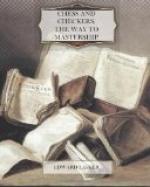B-a3. Again a waiting move. White cannot play Kt-h6 right away as Black would be stalemate. (17) ..., K-g8; (18) Kt-h6, K-h8; (19) B-b2 mate.
It is not possible to force a mate with King and two Knights, for even if a position similar to Diagram 13 is arrived at, in which the King can be driven into the corner, the Knight who prevents the King from escaping is never ready to give the checkmate, and in order to prevent a stalemate the other Knight would have to let the King out of the corner again. If Black had a spare move, for instance if he had a Pawn left, then White would win. (1) Kt-a6, K-a8; (2) Kt-e8, Pawn moves; (3) Kt-c7 mate.
RELATIVE VALUE OF THE MEN
From the foregoing examples it is possible to form a vague idea of the strength of the different pieces. The Queen is apparently the strongest piece. On account of her superior mobility she can confine the hostile King with a few moves and force him into a mating net. Of the other pieces the Rook is no doubt the strongest for he is sufficient to force a mate in conjunction with his own King, while Bishop or Knight cannot do so. Two Bishops apparently are stronger than two Knights, while it is not possible yet to say anything about the relative value of one Bishop and one Knight.
The above valuation, however, holds good only on the comparatively vacant board, where the pieces can make full use of their mobility. It is the mobility alone which decides the value of a man, and positions often occur in which a Knight is more valuable than a Rook or in which a Pawn might be preferable to a Bishop and so on. The reason is that sometimes the weaker man occupies a commanding square while the stronger man is obstructed somehow or other so that he cannot be made to work. Examples for positions of this kind will be discussed in the Chapter on combination.
Although it is impossible to indicate exactly the relative value of the men in each position, experience enables a fair estimation of their average strength. The Queen is about as strong as two Rooks or as three minor pieces (Bishops or Knights). A minor piece is about equivalent to three Pawns, and a Rook is consequently equal to a minor piece and one to two Pawns.
The value of a Pawn is the hardest thing to grasp for the beginner. A Pawn appears to be of so little use on account of his limited mobility, that it seems hardly worth while to waste time on saving a Pawn that is attacked, as so much greater things are apparently at issue. What he overlooks is the latent value of the Pawn which lies in the possibility of queening him later in the game.
To realize the importance of the Pawn it is necessary to know exactly under what conditions he can be queened. This knowledge is all the more indispensable to the Chess player as the vast majority of all games finally resolve themselves into Pawn endings in which the advantage of one or more Pawns decides the issue.




